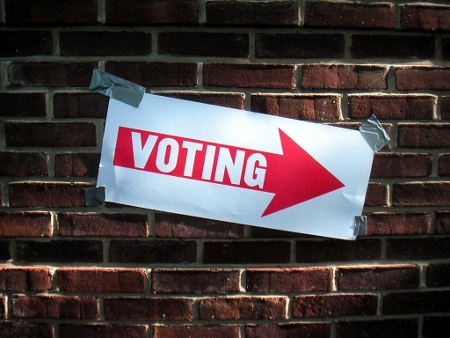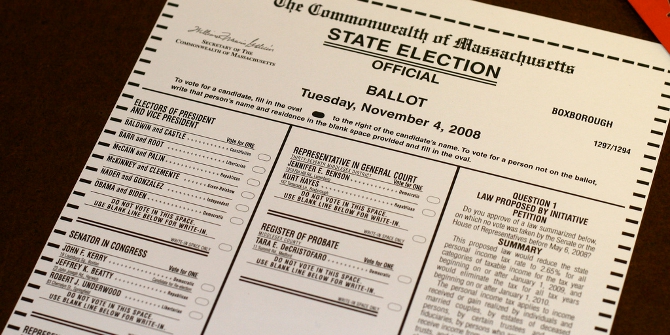 Recent months have seen concern over voter identification measures that have been introduced that may have the effect of reducing turnout among voters from low income groups. While many maintain that greater turnout among those on low incomes will mean that government spends more on those groups, new research from Lucy Barnes casts doubts on these accounts. Looking at differences in government spending, and spending targeted towards the poor, across the American states between 1978 and 2002, she finds that with turnout at such a low level at this point, any increases will have little relationship with levels of government spending.
Recent months have seen concern over voter identification measures that have been introduced that may have the effect of reducing turnout among voters from low income groups. While many maintain that greater turnout among those on low incomes will mean that government spends more on those groups, new research from Lucy Barnes casts doubts on these accounts. Looking at differences in government spending, and spending targeted towards the poor, across the American states between 1978 and 2002, she finds that with turnout at such a low level at this point, any increases will have little relationship with levels of government spending.
Recent debates on the introduction of stringent voter identification laws have sparked renewed discussion of the importance of the representation of low income voters. In addition to the self-evident reasons why equal representation is necessary for democracy to function, there are reasons to expect that political participation affects policy outcomes, too. In particular, the representation of low income interests may have important effects on the attention– and resources—that governments devote to lower income citizens.
Three simple intuitions and stylized facts underpin conventional accounts of government spending, and its variation across jurisdictions– whether countries, or subnational regions such as the American states. First, citizens with lower incomes prefer higher levels of spending, and greater spending on programs to aid the poor. At the same time, socioeconomic status, defined in terms of income and education, strongly affects political participation: richer individuals vote at higher rates than their low income counterparts. Finally, where turnout is higher, public policy tends to be relatively more generous to the poor.

Taken together, these patterns seem to imply that the impact of turnout on policy should work through the individual characteristics of voters (their income) and thereby their preferences over public policy. Higher turnout means a greater representation among voters by those on low incomes, so the majority of voters then prefer greater government spending. This logic parallels the Meltzer-Richard theory of the size of government whereby greater inequality has the same effect as high turnout—by lowering the relative income of the median voter (also known as the ‘decisive voter’)– and therefore leading to higher levels of spending by government.
Appropriate tests of these individual-level mechanisms are difficult to devise, however. Public policy responds to many factors other than the preferences of voters, not least its own local history, while turnout and inequality are downstream consequences of prior policy choices. Thus there are good reasons to be cautious about inferring the individual-level mechanisms from aggregate data. This also points towards trying to isolate relevant changes from broader cross-national differences, as much of the research on the mechanisms underpinning spending choices consider national policy choices.
In recent research, I have looked at differences in government spending, and spending targeted towards the poor, across the American states. This also allows for detailed investigation of the income mechanisms involved, as the Current Population Survey provides data, representative at the state level, on both income and (reported) voter participation. From this individual-level data I constructed measures of the income of the median voter for every state-year from 1978 to 2002. In considering the relationship between median voter income, spending, and the typical aggregate measures of turnout and inequality, we can investigate whether the mechanisms purported to explain the macro-level relationships (that higher inequality and turnout drive higher spending).
First, does the income of the median voter matter for the level of government spending? I find little evidence that it does. Or rather, there is some evidence of a statistically discernible effect, but its substantive size is very small. For a thousand dollar increase in the gap between average income and the income of the median voter, annual public welfare spending per capita increases by $6! Total government spending declines with the decisive voter’s income shortfall, but again the size of these effects is tiny– around $40 for a $1000 change. This small effect size, more than the statistical insignificance of the effects, indicates that any impact of the income of the decisive voter on policy outcomes is limited. Second, if the income of voters as a whole, which depends on inequality and who turns out to vote, is the mechanism by which these factors affect spending, we should see the effects of these aggregate-level variables reduced once the direct measure is included as a predictor in the statistical model. I find no evidence that this is the case, either.
What explains this puzzling (lack of a) result? In the case of inequality, it is perhaps less surprising: a common theme in studies of the impact of inequality on redistributive government spending is the absence of consistent effects, despite the logic of the underlying theory. But what about turnout? Given that participation is biased towards the rich, surely lower turnout should disempower pro-spending voters?
It turns out that when we analyze the relationship between aggregate levels of turnout and the income of the decisive voter– for the American states in the time period in question– there is little relationship between the two measures. Lower turnout does not seem to have strongly affected the income of the median voter. This finding contrasts with results from cross-national studies, where higher turnout and better representation of the poor in the electorate are closely linked. However, the context matters. In cross-national comparisons, high-turnout countries see voting at near-universal rates. In contrast, in the United States data analysed here, turnout ranges from 40 to 73 percent, averaged across four-year electoral cycles. At this level of abstention, the necessary relationship between higher turnout and greater equality in turnout may no longer hold. That is, the impact of socioeconomic status is consistent enough to be important in differentiating individuals, but the size of its effect is dwarfed by other factors that can drive abstention, when these rates are high, in terms of aggregate effect.
Does this imply that recent concerns over voter registration and identification laws are misplaced? No. While the socioeconomic bias in voting has not been sufficient to systematically link turnout levels to the representation of lower income groups in the past thirty years, this is a result of the political mobilization efforts of both parties, and the institutional rules governing voting. The absence of effects under these conditions is no cause for complacency: rules that will systematically work to reduce turnout among lower income individuals are likely to induce the very relationships that we have failed to find.
This article is based on the paper, Does Median Voter Income Matter? The Effects of Inequality and Turnout on Government Spending, in the March 2013 issue of Political Studies.
Please read our comments policy before commenting.
Note: This article gives the views of the authors, and not the position of USApp– American Politics and Policy, nor of the London School of Economics.
Shortened URL for this post: http://bit.ly/M8kTXe
_________________________
 Lucy Barnes – Nuffield College, Oxford
Lucy Barnes – Nuffield College, Oxford
Lucy Barnes is a Prize Postdoctoral Research Fellow at Nuffield College, Oxford. Her research focuses on contemporary causes and consequences of inequality and government redistribution in the advanced industrial democracies, and their historical development. She is currently working on a project on the political economy of progressive taxation, and is interested in the implications of the ‘great recession’ on government, policy and inequality.






